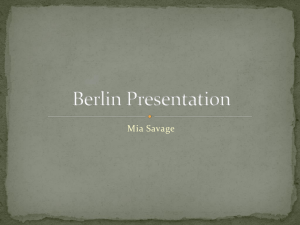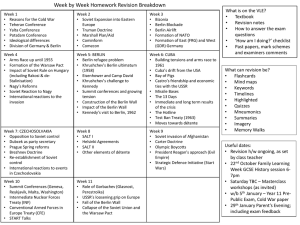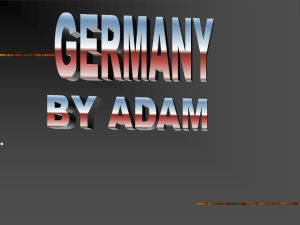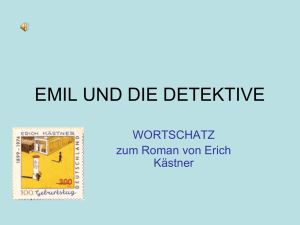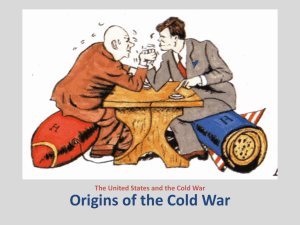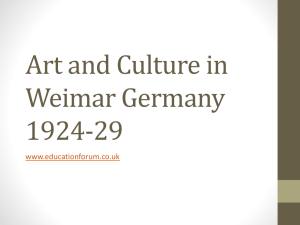GYAGA 2011, March 20-22, Berlin, Germany
advertisement
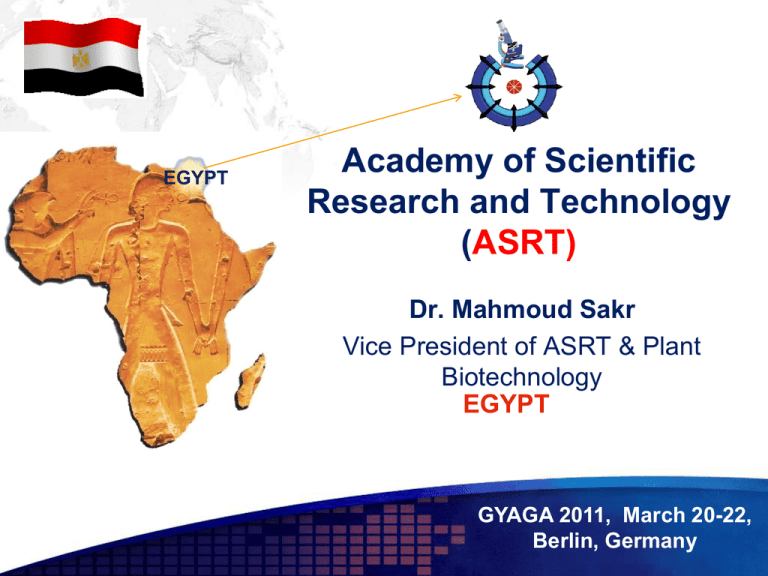
EGYPT Academy of Scientific Research and Technology (ASRT) Dr. Mahmoud Sakr Vice President of ASRT & Plant Biotechnology EGYPT GYAGA 2011, March 20-22, Berlin, Germany Contents 1 Introduction about Egypt 2 Brief description of S&T system 3 Brief description of ASRT 4 5 Youth programs in Egyptian ST system Int. cooperation GYAGA 2011, March 20-22, Berlin, Germany Egypt is located in the heart of the Middle East linking between Africa and Asia. With 85 Million people and one of every four Arabs is an Egyptian. With more than 17 Million students in the Education System and 100,000 researchers. 60% of population are youth GYAGA 2011, March 20-22, Berlin, Germany Alexandria, Egypt, summer 2010 4000 BC GYAGA 2011, March 20-22, Berlin, Germany 4000 BC 25 January, 2011 GYAGA 2011, March 20-22, Berlin, Germany Egypt (Nobel Laureates) Mohamed El Baradei, Peace, 2005 Ahmed Zewail, Chemistry, 1999 Naguib Mahfouz, Literature, 1988 Anwar El Sadat, Peace, 1978 25 January Revolution, Peace Sadat Mahfouz Zewail El Baradi who is the next? 25 January Revolution GYAGA 2011, March 20-22, Berlin, Germany You Are Invited to Visit Egypt which we do not GYAGA 2011, March 20-22, Berlin, Germany Contents 1 Introduction about Egypt 2 Brief description of S&T system 3 Brief description of ASRT 4 5 Youth programs in Egyptian ST system Int. cooperation GYAGA 2011, March 20-22, Berlin, Germany Ongoing ST policy 1) Re-Structuring of Science and Technology System. 2) National Initiative for Human Resources Development. 3) Priority National Projects. 4) Funding of Science and Technology. 5) National Initiative for Informal Education and vocational training. 6) National Initiative for Innovation. GYAGA 2011, March 20-22, Berlin, Germany S&T System 73% in University 13% in Institutes 14% in Industry HCST 100 000 Researchers Universities (25 +25) Research Centers (362) Private Sector (Industry) GYAGA 2011, March 20-22, Berlin, Germany Egypt’s S&T priority areas: Phase ONE 1) Energy Resources - Technology Transfer of Wind Turbines. - Concentrated Solar Power. - Photo-voltics thin films with Nanotechnology. 2) Water and Environment - Non-Traditional Water Resources Management. - Desalination with renewable energy sources. 3) Food and Agriculture - Increasing yield of economic crops. - Increasing marine aqua-culture of fishes. GYAGA 2011, March 20-22, Berlin, Germany Egypt’s S&T priority areas Phase ONE 4) Health - Combating Hepatitis C virus disease. 5) Space, Remote sensing and ICT - Earth observation and Climate Change. - Super-, grid-computing and data mining. GYAGA 2011, March 20-22, Berlin, Germany Targeted Calls Renewable Energy HCV • Wind Energy • Solar Energy: CSP and PV • Epidemiology of HCV infection • Peaceful applications of Nuclear • HCV diagnostic modalities Energy • HCV therapy Water Sustainable Improvement of Food production • HCV prevention Desalination • Resistance to abiotic stresses in strategic crops • Irrigation systems • Fisheries and fish farming GYAGA 2011, March 20-22, Berlin, Germany STI indicators GYAGA 2011, March 20-22, Berlin, Germany KOICA, Technology and Policy (TAP), June 2010, Korea KOICA, Technology and Policy (TAP), June 2010, Korea KOICA, Technology and Policy (TAP), June 2010, Korea Number of patents granted by the Egyptians Egyptian Patent Office European Patent Offic 80 U.S. Patent Office 70 patent granted 60 80 58 50 50 40 30 23 30 16 17 15 20 12 10 0 2005 2006 2007 GYAGA 2011, March 20-22, Berlin, Germany Incomplete Cycle of Innovation National Science Foundation, 2008, Science and Engineering Indicators 2008 GYAGA 2011, March 20-22, Berlin, Germany Bloom ing Biotech South Korea • Incomplete Cycle of Innovation China India 1991 2002 Brazil South Africa Cuba Egypt 0 50 100 150 200 250 300 350 Chart of Papers in Biotechnology in Developing Countries GYAGA 2011, March 20-22, Berlin, Germany • Incomplete Cycle of Innovation India South Korea China Brazil Cuba South Africa Egypt Chart of Patents in Biotechnology in Developing Countries GYAGA 2011, March 20-22, Berlin, Germany OUR mission = Bridge the gap GYAGA 2011, March 20-22, Berlin, Germany Contents 1 Introduction about Egypt 2 Brief description of S&T system 3 Brief description of ASRT 4 5 Youth programs in Egyptian ST system Int. cooperation GYAGA 2011, March 20-22, Berlin, Germany ASRT, 101 Kasr االبتكار و هبا ىف نشر الثقافة العلمية وتشجيع وAlحتفيز Ani Street, احمللية Cairo,السلطات اجملتمع ،وذلك بالتعاون مع اجملتمع املدىن و Egypt تقوم االكادميية بالدور املنوط االخرتاع وحب العلوم وتنمية واجلهات املعنية بالتعليم والبحث العلمى والثقافة ،وذلك من خالل جمموعة من مراكز التنمية االقليمية املنتشرة ىف االقاليم املختلفة ،حيث تعترب مراكز التنمية االقليمية نقاط ارتكاز لالكادميية ىف االقاليم املصرية. www.asrt.sci.eg GYAGA 2011, March 20-22, Berlin, Germany The ASRT was established in September, 1971 as being the national body responsible for science and technology in Egypt . GYAGA 2011, March 20-22, Berlin, Germany About us ASRT is the Egyptian house of expertise. It brings together outstanding Egyptian scientists from universities, research institutions, private sector, NGOs, policymakers and prominent Egyptian scientists in Diaspora. ASRT experts deliberate country problems, propose and carry out the needed scientific future studies and strategic plans to tackle these problems. GYAGA 2011, March 20-22, Berlin, Germany Vision To be effective and reliable national think tank for the service of Science, Technology and Innovation (STI) in Egypt GYAGA 2011, March 20-22, Berlin, Germany Mission To create enabling and stimulating environment for STI. For maximizing the outcomes of STI. Through promotion, coordination, assessment, encouragement and appreciation of excellence in STI. GYAGA 2011, March 20-22, Berlin, Germany Activities 1.Future studies, strategic plans and roadmaps to tackle country problems. 2.Strengthen cooperation with international (Academies, STI institutions, IAP,..etc). counterparts 3.Raise the awareness and promotion of scientific culture & thinking. 4.Assessment of science and technology (ST indicators). 5.Encourage and honoring excellence in Science. GYAGA 2011, March 20-22, Berlin, Germany Activities (cont.) 6. Establishment and taking care of virtual multiinstitutional centres of excellence and research consortia in advanced and converging sciences. 7. Bridging the gap between scientists and private sector. 8. Supports the complete cycle of innovation 9. Empowering of youth and women in STI system* *Promotion of Egyptian Young Academy of Science (EYAS) *Egyptian Woman Academy of Science (EWAS) GYAGA 2011, March 20-22, Berlin, Germany GYAGA 2011, March 20-22, Berlin, Germany Contents 1 Introduction about Egypt 2 Brief description of S&T system 3 Brief description of ASRT 4 5 Youth programs in Egyptian ST system Int. cooperation GYAGA 2011, March 20-22, Berlin, Germany I: Scientists for next generation Since 2008 GYAGA 2011, March 20-22, Berlin, Germany What is SNG? ASRT offers grants M.Sc grants for highly qualified Egyptian fresh graduate on competitive basis, to bridge the gap between scientific research and the requirements of the national labor market and research institutions, which requires a high degree of skill in the performance GYAGA 2011, March 20-22, Berlin, Germany Objectives: Prepare young researchers to lead scientific research in their organizations. Utmost use of juniors HR. Advance researcher’s knowledge and skills on new scientific technologies, which can be used to improve economy. Foster ties between researchers and the community through joint training workshops and joint supervision. Enhance researcher’s international levels. networking at national, regional and Provide participants with the body of knowledge required for selfassessment and continuous improvement of their performance. GYAGA 2011, March 20-22, Berlin, Germany Benefits: Appropriate monthly financial grant (LE 1000). Access to current support for the purchase of some equipment and research purposes (LE 20 000). Attend general and specialized courses (LE 10 000). Award the trainee a certificate at the end of training authorized by ASRT and endorsed by the Supreme Council of Universities. The specialized courses cover the areas of water, space, life sciences, humanities and social sciences, engineering, basic sciences, energy agriculture and ICT. 350 Egyptian fresh graduates were benefited from this program GYAGA 2011, March 20-22, Berlin, Germany II: Egyptian Youth Academy of Science (2011) GYAGA 2011, March 20-22, Berlin, Germany GYAGA 2011, March 20-22, Berlin, Germany EYAS: EYAS is an outcome of the confidence of the government of Egypt in youth as the main vehicle of development of modern Egypt, where Egypt is a juvenile country and the youth represents about 60% of total population. EYAS is also an international commitment of ASRT in the Inter Academy Panel (IAP) initiative aiming at empowering youth and women in science and technology. ASRT will host EYAS secretariat (hub), provide the support and spin off *Independent legal body of STI system *Juvenile instrument to promote STI in the country *Debate country problems and propose the solution GYAGA 2011, March 20-22, Berlin, Germany III: Center of Excellence for Advanced Sciences (CEAS) Since 2006 GYAGA 2011, March 20-22, Berlin, Germany Mission To maximize the outcomes of highly qualified juniors and seniors in advanced sciences, Through Creation of encouraging scientific environment, Changing brain drain to brain gain, GYAGA 2011, March 20-22, Berlin, Germany National Research Centre Centre of Excellence of Advanced Sciences (Nobel Project) Track I : Biotechnology Research Groups 1-Plant Molecular Genetics Track II : Pharmaceutical Research Groups 2- Vaccines 1- Pharmaceutical Research Lab (Prof. M. Abdel Rehim) 3- Infectious Diseases & Immunology 2- Medicinal Chemistry & Drug Design 4- Cancer Biology 3- Chemistry Marine Natural Products Track III : Advanced Materials and Renewable Energy Research Groups 1- Advanced Materials & Nanotechnology 2- Renewable Energy 3- Laser Technology 5- Stem Cells Research 6- Genetics of Hydrobiology 7- Safe Agriculture Track VI : Research and Service Units 8- Food Risk Analysis & Food Virology 9-Tumor Molecular Pathology 10- Bio - Informatics Central Core Facilities Lab (Biotech.) Central Core Facilities Lab (Nanotech.) Service Unit for Advanced Technologies The criteria for selection the staff members included: Age (below 40), International publications, Research grants, Scientific prizes Good scientific international relations with developed schools abroad. Preference is given to candidates having their Ph. D from developed countries. GYAGA 2011, March 20-22, Berlin, Germany Seasonal Evaluation Evaluation Criteria International Publications Research Projects (In-house, Nat., Int.) Scientific Prizes (In-house, Nat., Int.) Patents (Nat., Int.) Other Scientific Activities GYAGA 2011, March 20-22, Berlin, Germany Number of Evaluated Researchers GYAGA 2011, March 20-22, Berlin, Germany International Publications GYAGA 2011, March 20-22, Berlin, Germany CEAS Publications as Compared with NRC GYAGA 2011, March 20-22, Berlin, Germany CEAS Projects as compared with NRC GYAGA 2011, March 20-22, Berlin, Germany Number of Projects Per Person GYAGA 2011, March 20-22, Berlin, Germany CEAS Prizes as Compared with NRC GYAGA 2011, March 20-22, Berlin, Germany CEAS Patents as Compared with NRC GYAGA 2011, March 20-22, Berlin, Germany IV-Young Researchers Grants V- Reintegration programs GYAGA 2011, March 20-22, Berlin, Germany STDF Research Grants Schemes Young Researcher • YR based in Egypt • Ph.D. from a reputable • < 40 yrs Uni. (within last 5 yrs) • PhD within last 10 yrs • < 35 yrs • 3 Years • 3 Years • L.E 600,000 • L.E up to 1,500,000 - Landscape for R&D community - Brain Gain - Capacity building - Strengthening R&D community - Minimize brain drain Basic & Applied Reintegration • Any researcher(s) based in Egypt • 2 Years • L.E 1,000,000 - Landscape for R&D community - Capacity building GYAGA 2011, March 20-22, Berlin, Germany Contents 1 Introduction about Egypt 2 Brief description of S&T system 3 Brief description of ASRT 4 5 Youth programs in Egyptian ST system Int. cooperation GYAGA 2011, March 20-22, Berlin, Germany Country Spain Corresponding Institutions Country Corresponding Institutions Italy The Council of Scientific Research of the Kingdom Australia of Spain National Research Council of Italy Brazil Bulgaria Bulgarian Academy of Science North Korea The National Council for Scientific and technological development of Brazil The Academy of science of Korea Poland Polish Academy of Science Malaysia The Academy of Sciences Malaysia Hungary Hungarian Academy of Science Romania The National Committee of Science and Technology of Romania Germany The Deutsche Forschungsgemeinschaft Ukraine The National Academy of Science of Ukraine France National Research Center of France Jordan The Supreme Council of Science and Technology Slovakia Slovak Academy of Science Iraq The Council of Scientific Research Czech Czech Academy of Science Sudan The National Research Council of Sudan Turkey Libya The National Research Authority Austria The Scientific and Technological Council of Turkey Austrian Academy of Science Morocco Cyprus The Research Promotion Foundation of Cyprus South Africa The National Scientific Research and Technical coordination and Planning Center The Foundation for research development of South Africa Kazakh The Council for human Research The Academy of Sciences of Kazakh Albania The Academy of Sciences of Albania Russian federation Uzbekistan The Russian Academy of Sciences South Korea Korea Science and Engineering Foundation China Korea Research Foundation National Natural Science Foundation of China The Australian Ministry of Sciences The Academy of Science of China Belarus The National Academy of Belarus Finland The Academy of Finland India The Scientific and industrial council of India The Academy of Science of Uzbekistan The Academy of Agriculture of India GYAGA 2011, March 20-22, Berlin, Germany Thank You Mahmoud Sakr, NRC, Egypt
